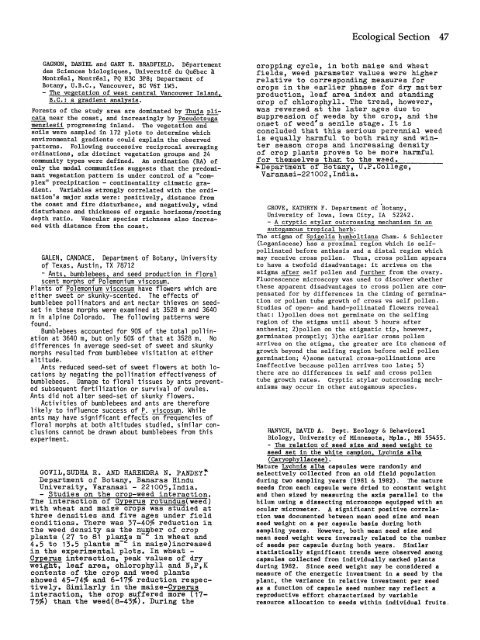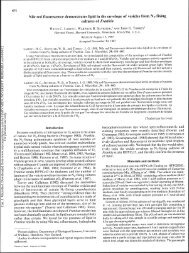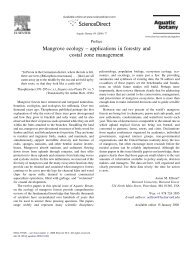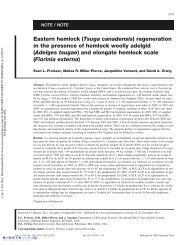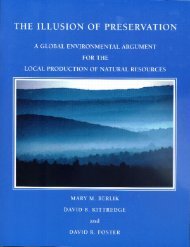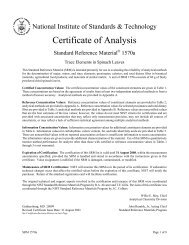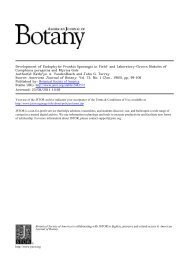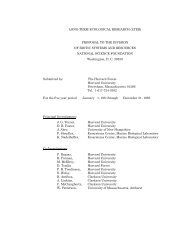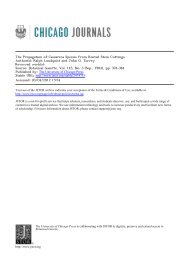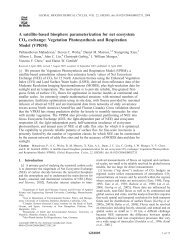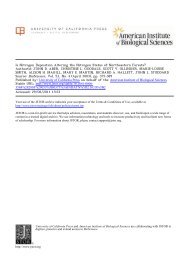Abstracts of Papers - Harvard Forest - Harvard University
Abstracts of Papers - Harvard Forest - Harvard University
Abstracts of Papers - Harvard Forest - Harvard University
You also want an ePaper? Increase the reach of your titles
YUMPU automatically turns print PDFs into web optimized ePapers that Google loves.
GAGNON, DANIEL and GARY E. BRADFIELD. Departement<br />
des Sciences biologiques, Universite du Quebec a<br />
Montreal, Montreal, PQ H3C 3P8; Department <strong>of</strong><br />
Botany, U.B.C.,<br />
- The vegetation<br />
Vancouver, BC V6T 1W5.<br />
<strong>of</strong> west central Vancouver Island,<br />
B.C.: a gradient analysis.<br />
<strong>Forest</strong>s <strong>of</strong> the study area are dominated by Thuja pli-<br />
cata near the coast, and increasingly by Pseudotsuga<br />
menziesii progressing inland. The vegetation and<br />
soils were sampled in 172 plots to determine which<br />
environmental gradients could explain the observed<br />
patterns. Following successive reciprocal averaging<br />
ordinations, six distinct vegetation groups and 24<br />
community types were defined. An ordination (RA) <strong>of</strong><br />
only the modal communities suggests that the predomi-<br />
nant vegetation pattern is under control <strong>of</strong> a "com-<br />
plex" precipitation - continentality climatic gra-<br />
dient. Variables strongly correlated with the ordi-<br />
nation's major axis were: positively, distance from<br />
the coast and fire disturbance, and negatively, wind<br />
disturbance and thickness <strong>of</strong> organic horizons/rooting<br />
depth ratio. Vascular species richness also increa-<br />
sed with distance from the coast.<br />
GALEN, CANDACE. Department <strong>of</strong> Botany, <strong>University</strong><br />
<strong>of</strong> Texas, Austin, TX 78712<br />
- Ants, bumblebees, and seed production in floral<br />
scent morphs <strong>of</strong> Polemonium viscosum.<br />
Plants <strong>of</strong> Polemonium viscosum have flowers which are<br />
either sweet or skunky-scented. The effects <strong>of</strong><br />
bumblebee pollinators and ant nectar thieves on seed-<br />
set in these morphs were examined at 3528 m and 3640<br />
m in alpine Colorado. The following patterns were<br />
found.<br />
Bumblebees accounted for 90% <strong>of</strong> the total pollin-<br />
ation at 3640 m, but only 50% <strong>of</strong> that at 3528 m. No<br />
differences in average seed-set <strong>of</strong> sweet and skunky<br />
morphs resulted from bumblebee visitation at either<br />
altitude.<br />
Ants reduced seed-set <strong>of</strong> sweet flowers at both lo-<br />
cations by negating the pollination effectiveness <strong>of</strong><br />
bumblebees. Damaqe to floral tissues by ants prevent-<br />
ed subsequent fertilization or survival <strong>of</strong> ovules.<br />
Ants did not alter seed-set <strong>of</strong> skunky flowers.<br />
Activities <strong>of</strong> bumblebees and ants are therefore<br />
likely to influence success <strong>of</strong> P. viscosum. While<br />
ants may have significant effects on frequencies <strong>of</strong><br />
floral morphs at both altitudes studied, similar con-<br />
clusions cannot be drawn about bumblebees from this<br />
experiment.<br />
GOVIL, SUDHA R. AND HARENDRA N. PAMTEYB<br />
Department <strong>of</strong> Botany, Banaras Hindu<br />
<strong>University</strong>, Varanasi - 221005,India.<br />
- Studies on the crop-weed interaction.<br />
The interaction <strong>of</strong> Cyperus rotundus(weed)<br />
with wheat and maize crops was studied at<br />
three densities and five ages under field<br />
conditions. There was 37-40% reduction in<br />
the weed density as the nuPber <strong>of</strong> crop<br />
plants (27 to 81 planLas m in wheat and<br />
4.5 to 13.5 plants m in maize)increased<br />
in the experimental plots. In wheat -<br />
Cyperus interaction, peak values <strong>of</strong> dry<br />
weight, leaf area, chlorophyll and N,P, K<br />
contents <strong>of</strong> the crop and weed plants<br />
showed 45-74% and 6-17% reduction respec-<br />
tively. Similarly in the maize-Cyperus<br />
interaction, the crop suffered mre (1&T7-<br />
7 5%) than the weed( 8-43%) . During the<br />
Ecological Section 47<br />
cropping cycle, in both maize and wheat<br />
fields, weed parameter values were higher<br />
relative to corresponding measures for<br />
crops in the earlier phases for dry matter<br />
production, leaf area index and standing<br />
crop <strong>of</strong> chlorophyll. The trend, however,<br />
was reversed at the later ages due to<br />
suppression <strong>of</strong> weeds by the crop, and the<br />
onset <strong>of</strong> weed' s senile stage. It is<br />
concluded that this serious perennial weed<br />
is equally harmful to both rainy and win-<br />
ter season crops and increasing density<br />
<strong>of</strong> crop plants proves to be more harmful<br />
for themselves thar to the weed.<br />
-Department <strong>of</strong> Botany, U.P.College,<br />
Varanasi-221002, India.<br />
GROVE, KATHRYN F. Department <strong>of</strong> Botany,<br />
<strong>University</strong> <strong>of</strong> Iowa, Iowa City, IA 52242.<br />
- A cryptic stylar outcrossing mechanism in an<br />
autogamous tropical herb:<br />
The stigma <strong>of</strong> Spigelia humboltiana Cham. & Schlecter<br />
(Loganiaceae) has a proximal region which is self-<br />
pollinated before anthesis and a distal region which<br />
may receive cross pollen. Thus, cross pollen appears<br />
to have a tw<strong>of</strong>old disadvantage: it arrives on the<br />
stigma after self pollen and further from the ovary.<br />
Fluorescence microscopy was used to discoVer whether<br />
these apparent disadvantages to cross pollen are com-<br />
pensated for by differences in the timing <strong>of</strong> germina-<br />
tion or pollen tube growth <strong>of</strong> cross vs self pollen.<br />
Studies <strong>of</strong> open- and hand-pollinated flowers reveal<br />
that: 1)pollen does not germinate on the selfing<br />
region <strong>of</strong> the stigma until about 5 hours after<br />
anthesis; 2)pollen on the stigmatic tip, however,<br />
germinates promptly; 3)the earlier cross pollen<br />
arrives on the stigma, the greater are its chances <strong>of</strong><br />
growth beyond the selfing region before self pollen<br />
germination; 4)some natural cross-pollinations are<br />
ineffective because pollen arrives too late; 5)<br />
there are no differences in self and cross pollen<br />
tube growth rates. Cryptic stylar outcrossing mech-<br />
anisms may occur in other autogamous species.<br />
HANYCH, DAVID A. Dept. Ecology & Behavioral<br />
Biology, <strong>University</strong> <strong>of</strong> Minnesota, Mpls., MN 55455.<br />
- The relation <strong>of</strong> seed size and seed weight to<br />
seed set in the white campion, Lychnis alba<br />
(Caryophyllaceae).<br />
Mature Lychnis alba capsules were randomly and<br />
selectively collected from an old field population<br />
during two sampling years (1981 & 1982). The mature<br />
seeds from each capsule were dried to constant weight<br />
and then sized by measuring the axis parallel to the<br />
hilum using a dissecting microscope equipped with an<br />
ocular micrometer. A significant positive correla-<br />
tion was documented between mean seed size and mean<br />
seed weight on a per capsule basis during both<br />
sampling years. However, both mean seed size and<br />
mean seed weight were inversely related to the number<br />
<strong>of</strong> seeds per capsule during both years. Similar<br />
statistically significant trends were observed among<br />
capsules collected from individually marked plants<br />
during 1982. Since seed weight may be considered a<br />
measure <strong>of</strong> the energetic investment in a seed by the<br />
plant, the variance in relative investment per seed<br />
as a function <strong>of</strong> capsule seed number may reflect a<br />
reproductive effort characterized by variable<br />
resource allocation to seeds within individual fruits.


